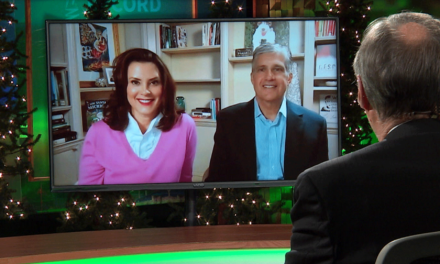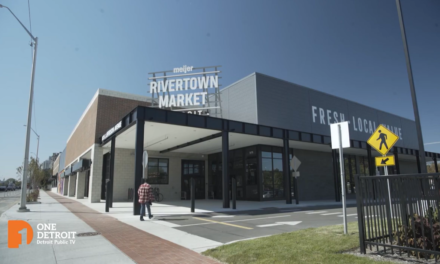The latest data from the U.S. Office of Minority Health shows African Americans are 20% more likely to experience serious mental health issues than the general population, with several disparities and factors impacting education, awareness and access to mental health services. A lack of equitable access to services, the stigmas associated with seeking mental help in the Black community, and racial discrimination in healthcare all create more barriers for African Americans to find help.
RELATED: Making Mental Health Better for Communities of Color
For National Mental Health Awareness Month, host Stephen Henderson talks with Eric Doeh, President & CEO of Detroit Wayne Integrated Health Network (DWIHN), about the pandemic’s impact on mental health, the stigma of mental illness in the African American community, economic barriers and health disparities affecting minorities, and access to mental healthcare services.
Full Transcript:
Stephen Henderson: I want to start with what I think is the crux of this issue, especially in a city like Detroit, and it is this stigma that continues to kind of follow the issue of mental illness, especially in the black community. Of course, there is a stigma in our society in general around the idea of mental illness, and I think there are lots of things we don’t understand about it, or really understand how to treat it, but this is a particular issue with African Americans. And so, with May being Mental Health Awareness Month, I want to give you a chance to talk about how hard that stigma makes it to make progress.
Eric Doeh, CEO & President, Detroit Wayne Integrated Health Network: Absolutely. You know, when you talk about trauma, in particular, trauma amongst our youth and children, you know, when you hear a gunshot, and you talk to kids and that seems to be the norm; it’s not the norm. And, you know, for a long time, and even today, mental health sometimes is considered a weakness within the African American community.
And I find that so strange, you know, because everyone has an uncle or an aunt who from your time growing up, what you were told by the folks were that “Oh, that’s just, you know, James is going through it”, or whatever it was. And it creates such a challenge for us within the profession because we want to be accessible, we want to reach young people, we want to reach our seniors and, you know, our adults as well. But when you have that stigma out there, you first have to overcome that. And some of the ways in which you do that is simply by communicating and recognizing too, that mental health is no different from physical health.
There’s a reason why, Stephen, within our communities, we have urgent care centers there because we know that one day you and myself will be cooking and we’ll cut ourselves and we’ll need someplace to go to, to receive services. Within the behavioral health world, you come upon those challenges in life, you know, something happens that just completely change things for you and you need someone to talk to, and there is nothing wrong with that.
Stephen Henderson: So, let’s talk about how you approach then Mental Health Awareness Month here and in Wayne County, where, you know, the city of Detroit is the largest jurisdiction and it’s the largest majority black city in the country. There’s got to be an effect of those factors on the way that we even start to talk about mental health.
Eric Doeh: Absolutely. You know, at Detroit WIHN we serve well over 75,000 folks. Last year, even in the midst of COVID, we serve over 200,000 folks within Detroit. 40,000 of our core members are in the city. And so, whether we’re talking about our1-800 number, 1-(800)-241-4949, that’s a number that folks can use to access our services. Regarding our young folks, we also realize that, you know, Stephen, unlike you and myself back in the day, you know, we would pick up the phone and have a phone conversation, now young people text. So we came up with reachusdetroit.org, you know, you can use that for text messaging, you know, received well up to 12, you know, counseling sessions.
The same is true with our (313)-488-HOPE, another source that folks can call to receive services. What we find or what we are finding, though, is that you first have to start with access. Folks have to know who you are and what it is that you provide in terms of resources. The next step is then, how do you make those resources so that folks can come and receive those services, or you go to them? I mean, sometimes a mountain has to come to Moses and within the mental health space, transportation, you know, something to eat, a roof above your heads, those are all sorts of determinant factors that we have to be concerned with that are in the physical health world.
Your Dr. And my Dr. are not concerned as to how we’re making that appointment, but within the behavioral world, that matters, you know? So, we have made those things as part of our way of making sure that people have access to care and improving the quality of health for them as well.
Stephen Henderson: The access barriers also play a role here, and of course, play an outsized role in the African American community. I feel like that has gotten a bit better. There is more access now, thanks to the health care reform passed now almost a decade ago and enacted almost a decade ago. But we still have hurdles there and barriers to people being able to access mental health, which is still treated differently from an access standpoint than other health issues.
Eric Doeh: You know, and this is why when I have an opportunity to speak with folks such as Herman Moore, who, you know, he and I were on a program not too long ago and we talked about, you know, and here is a prominent athlete, you know, who was able to share his challenges growing up.
And I think when young folks, older folks recognize that you are not alone in this at all, you know, when you have athletes, you know, who have gone through this, Naomi Osaka, for example, you know, here is, you know, a tennis phenom who challenges with mental health was brought on the stage to have those types of discussions. I think when people see those things happening, there is an identification process there that says that you’re not alone in this. And I think the more opportunities that people get to see and hear this being discussed, it lessens the stigma.
A stigma will always be out there, let me make that very clear. You know, Stephen, I don’t think if we were to do an incredible job today or tomorrow, it would necessarily solve it. But I think some of the little things that we can do is to listen, we have to listen and understand what folks are going through. COVID exacerbated a lot of health challenges, you know, that were always there, but they were just brought to light in all of its prominence because of that.
Stephen Henderson: So, let’s talk more about the pandemic and the effect it has on the work to address mental health, in particular, I kind of identify a couple of different challenges there. One is, of course, the loss and the grief that so many people, especially in our community, experienced because of COVID. There’s the isolation that COVID forced on all of us and the disconnection from our families and our friends. And then, there is the economic insecurity that it absolutely inflicted on people, which is sometimes a trigger for mental health. It seems like you’ve got a lot on your plate there.
Eric Doeh: Absolutely. You know, and look, you have health disparities. And so, starting with that, and then you put the economic challenges and barriers that are also part of that, you know, so these are things that have always existed, you know, and there are times that we try to solve them as best as we can. But can you imagine?
Those things haven’t always been there. Now, you put COVID as part of that as well. And then there is also the sense of, you know, we are a community folks, African Americans, we love to be around each other. And I tell you, those were some difficult days and months to go through when, you know, you couldn’t go and see grandma, or you just couldn’t get into those communal settings that we’ve been so used to it.
But at the same time though, organizations such as ours, we were going out in the community with mobile health services because we realized that folks weren’t coming to buildings, so we needed to go to those spaces that they were in. Whether they were at community centers, parking lots that we find folks in, barbershops that we find folks in, you know, we needed to make sure that we kept connected with folks. And then, when you talk about technology, you know, folks often say, well, there’s always telehealth.
Well, in some of our communities, you know, access to the Web isn’t something that is as ready as our telephones, you know, so we had those challenges. And so, we invested in those communities by actually buying laptops and telephones. And now that you bought the laptops and telephones, you need to have the Internet sources that folks can use in order to access those services. So, we invested in those things, Stephen, because there was a recognition that we wanted to keep folks in contact with services and we wanted those services to continue.
Stephen Henderson: So, I also want to ask you about the way we should approach, not the people who are suffering from mental health challenges, but their families and the people closest to them, and what they can do to make this whole process easier? I think one of the things that we don’t talk enough about is the struggle of living with someone who has a mental health issue or challenge and making sure that that person is ready to get the help that they need and knows how to do it. What about the, I guess, caregiving aspect of this?
Eric Doeh: I’d say what a wonderful question. You know, people are not independent of others, they are connected to others. And this is why when we provide services, you know, to whether it is an adult or a child, we want to connect with the families. You know, when we talk about crisis services, for example, we don’t have a crisis center or a true crisis center here in Wayne County. We do in Oakland County in terms of common ground. At Detroit – Wayne, we are building one by the end of this month, we will have one built here. What that does, though, now you’re talking about someone in terms of a family member who realizes that, gosh, I have, you know, a loved one here who’s struggling, but I have nowhere to turn.
I either call the police or I take them down to the emergency room. The emergency room is not a place for folks who are experiencing mental health challenges to be treated. I mean, it’s just not and Dr.’s will tell you that any day. The jail setting is also not a place for folks to receive services when they’re going through those challenges. So, we want to be able to connect with families to let them know that we are a resource. It starts with educating them first, but in educating you also have to have the resources that are connected to that. And Stephen, this is why I tell people all the time, these are services that are free.
You know, they are free, free because your tax dollars are working for you. And I think when people know that there is that sense of you’re not alone in this in providing that care for your loved one. We are here to listen; we are also here to help as well.
Stay Connected:
Subscribe to Detroit Public Television’s YouTube Channel & Don’t miss American Black Journal on Tuesday at 7:30 p.m and Sunday at 9:30 a.m. on Detroit Public TV, WTVS-Channel 56.
Catch the daily conversations on our website, Facebook, Twitter and Instagram @amblackjournal.
View Past Episodes >
Watch American Black Journal on Tuesday at 7:30 p.m. and Sunday at 9:30 a.m. on Detroit Public TV, WTVS-Channel 56.




